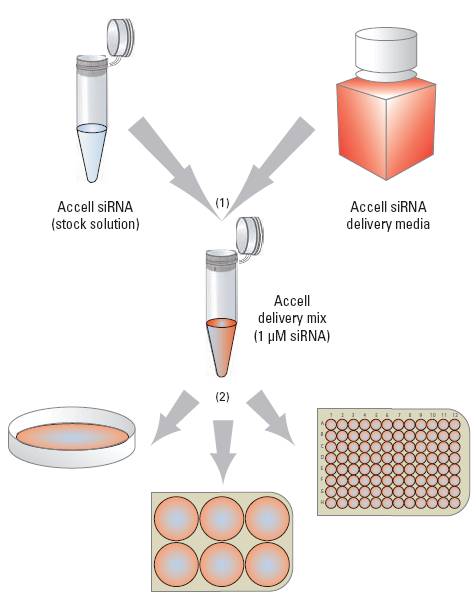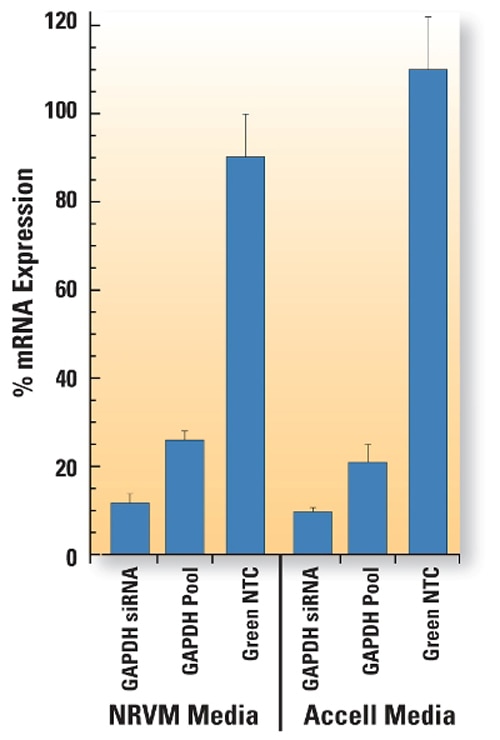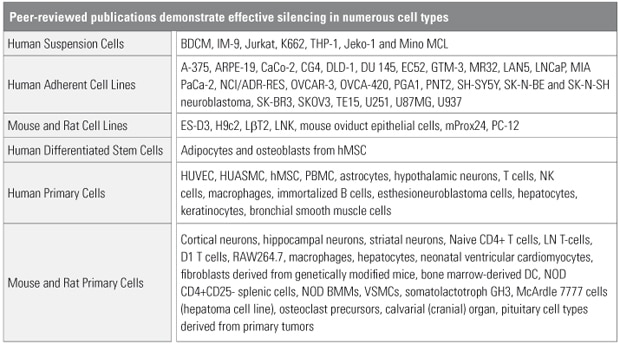- Products
- トランスフェクション試薬とバッファー
Accell siRNA Delivery Media

Accell siRNA Delivery Media is an enriched, serum-free media specially formulated and optimized for Accell siRNA delivery. This product is the result of thorough testing of numerous formulations, and consistently shows strong delivery, knockdown, and high cell viability when used with Accell siRNA.
While not required for use with Accell siRNA, this media provides appropriate serum-free conditions for Accell uptake while maintaining cell health. It may be replaced with another serum-free or low-serum media, or supplemented with additives known to be necessary for cell health.
Highlights
- Validated in over 30 cell types for successful Accell siRNA application
- Maintains cell health while providing recommended serum-free application conditions
- Can be customized to your cell type with additives necessary for cell viability
Experimental Considerations
There are many cell-type specific considerations when working in low or no-serum conditions. Successful Accell siRNA results have been reported with a number of alternative conditions:
- Supplemental serum up to 2.5% (high serum conditions will interfere with Accell uptake)
- Growth factors and other additives (e.g. B27, insulin, glucose) necessary for cell health
- Standard cell culture media formulations (with reduced serum)
- Serum-free formulations (e.g. Neurobasal media)
We encourage testing of supplements or conditions that are known to benefit your particular cell type. Review the Accell Delivery Protocol for additional details.
The Accell siRNA application protocol simplifies targeted gene knockdown

The Accell siRNA application protocol simplifies targeted gene knockdown
(A) Combine Accell siRNA with Accell delivery media (or other low- or no-serum media). (B) Add Accell delivery mix directly to cells and incubate for 72 hours.
Effective Accell siRNA silencing in alternative media

Neonatal rat ventricular myocytes were incubated with 1 μM Accell Green (A; Cat# D-001950-01) or Red (B; Cat# D-001960-01) Non-targeting siRNA for 72 hours in Accell delivery media (Cat# B-005000). Nuclei were stained with DAPI (blue). Labeled control uptake showed diffuse cytoplasmic localization in nearly all cells. The bar graph indicates the level of gene silencing achieved with Accell GAPD Control siRNA (Cat# D-001930-03) and Accell GAPD Control Pool (Cat# D-001930-30) control reagents when used with neonatal rat ventricular myocyte (NRVM) media or Accell delivery media. Myocytes were prepared as described in Maass AH & Buvoli M. Cardiomyocyte preparation, culture, and gene transfer. Methods in Molecular Biology 2007;366: 321-30. mRNA expression was determined by QuantiGene branched DNA assay (Panomics).
Cell types demonstrating effective silencing with Accell siRNA

Cell types demonstrating effective silencing with Accell siRNA
Internal validation and peer-reviewed publications report numerous successes with difficult-to-transfect cell types. See the References tab for a list of publications.
References
Accell siRNA reagents in neuronal cells
- S. Suzuki et al.,Differential Roles of Epac in Regulating Cell Death in Neuronal and Myocardial Cells.J. Biol. Chem.285, 24248-24259 (Jul 2010). [primary mouse cortical neurons (E15-17)]
- A. M. Dolga et al., TNF-alpha-mediates neuroprotection against glutamate-induced excitotoxicity via NF-kappaB-dependent up-regulation of K2.2 channels.J. Neurochem.107(4), 1158-1167 (November 2008). [mouse primary cortical neurons]
- U. Dreses-Werringloer et al., A Polymorphism in CALHM1 Influences Ca2+ Homeostasis, Ab Levels, and Alzheimer’s Disease Risk.Cell.133(7), 1149-1161 (27 June 2008). [SHSY-5Y; human neuroblastoma]
- J. Sebo et al., Requirement for Protein Synthesis at Developing Synapses.J. Neurosci.29(31), 9778-9793 (5 August 2009). [rat primary hippocampal neurons]
- P. Mergenthaler et al., Mitochondrial hexokinase II (HKII) and phosphoprotein enriched in astrocytes (PEA15) form a molecular switch governing cellular fate depending on the metabolic state.PNAS USA.109(5), 1518-1523 (31 January 2012). [extended duration silencing in rat primary cortical neurons]
Citations
Accell siRNA reagents in neuronal cells
- S. Suzuki et al., Differential Roles of Epac in Regulating Cell Death in Neuronal and Myocardial Cells. J. Biol. Chem. 285, 24248-24259 (Jul 2010). [primary mouse cortical neurons (E15-17)]
- U. Dreses-Werringloer et al., A Polymorphism in CALHM1 Influences Ca2+ Homeostasis, Ab Levels, and Alzheimer’s Disease Risk. Cell. 133(7), 1149-1161 (27 June 2008). [SHSY-5Y; human neuroblastoma]
- J. Sebo et al., Requirement for Protein Synthesis at Developing Synapses. J. Neurosci. 29(31), 9778-9793 (5 August 2009). [rat primary hippocampal neurons]
- P. Mergenthaler et al., Mitochondrial hexokinase II (HKII) and phosphoprotein enriched in astrocytes (PEA15) form a molecular switch governing cellular fate depending on the metabolic state. PNAS USA. 109(5), 1518-1523 (31 January 2012). [extended duration silencing in rat primary cortical neurons]
Accell siRNA reagents in immunological cells
- S. Winning et al., Acute Hypoxia Induces HIF-Independent Monocyte Adhesion to Endothelial Cells through Increased Intercellular Adhesion Molecule-1 Expression: The Role of Hypoxic Inhibition of Prolyl Hydroxylase Activity for the Induction of NF-B J.Immunology. 185, 1786 -1793 (July 2010). [THP-1 monocytes]
- V. Saini et al.,CXC Chemokine Receptor 4 Is a Cell Surface Receptor for Extracellular Ubiquitin. J. Biol. Chem. 285(20), 15566-15576 (14 May 2010). [THP-1 monocytes]
- J. W. Perry et al., Endocytosis of Murine Norovirus 1 into Murine Macrophages Is Dependent on Dynamin II and Cholesterol. J. Virol. 84(12), 6163-6176 (June 2010). [murine macrophages]
- M. Steenport et al., Matrix Metalloproteinase (MMP)-1 and MMP-3 Induce Macrophage MMP-9: Evidence for the Role of TNF-a and Coclooxygenase-2. J. Immunology. 183(12), 8119-8127 (15 December 2009) [RAW264.7 macrophages, doi:10.4049/jimmunol.0901925]
- C. B. Lai et al., Creation of the two isoforms of rodent NKG2D was driven by a B1 retrotransposon insertion. Nucleic Acids Res. (2009). [mouse NK cell line, gkp174]
- N. Mookherjee et al., Intracellular Receptor for Human Host Sefense Peptide LL-37 in Monocytes. J. Immunol. 183(4), 2688-2696 (15 August 2009). [THP-1; human monocytes]
- D. Smirnov et al., Genetic Analysis of Radiation-induced Changes in Human Gene Expression. Nature. 459(7246), 587-591 (28 May 2009). [immortalized B cells]
- A. M. McElligott et al., The Novel Tubulin-Targeting Agent Pyrrolo-1,5-Benzoxazepine-15 Induces Apoptosis in Poor Prognostic Subgroups of Chronic Lymphocytic Leukemia. Cancer Research. 69(21), 8366-8375 (13 October 2009). [PGA-1; EBV-transformed chronic lymphocyctic leukemia (CLL) B cell line, 10.1158/0008-5472.CAN-09-0131]
Accell siRNA reagents in primary, stem, tumor and other cell types
- M. Liao et al., Inhibition of Hepatic Organic Anion-transporting Polypeptide by RNA Interference in Sandwich-cultured Human Hepatocytes: An in vitro Model to Assess Transporter-mediated Drug-drug Interactions.Drug Metabolism and Deposition. 38(9), 1612-1622 (August 2010). [freshly isolated human hepatocytes]
- S. Byas et al., Human Embryonic Stem Cells Maintain Pluripotency after E-Cadherin Expression Knockdown.FASEB J. 24, lb172 (April 2010). [H9 stem cell lines]
- S. Desai et al., PRDM1 Is Required for Mantle Cell Lymphoma Response to Bortezomib Mol.Cancer Res. 8, 907-918 (June 2010).
- I. Barbieri et al., Constitutively Active Stat3 Enhances Neu-Mediated Migration and Metastasis in Mammary Tumors via Upregulation of Cten. Cancer Res. 70, 2558-2567 (March 2010).
- C. Bartholomeusz et al., PEA-15 Induces Autophagy in Human Ovarian Cancer Cells and is Associated with Prolonged Overall Survival. Cancer Res. 68, 9302-9310 (2008). [OVCA 420; ovarian carcinoma]
- B. Tunquist et al., Mcl-1 Stability Determines Mitotic Cell Fate of Human Multiple Myeloma Tumor Cells Treated with the Kinesin Spindle Protein Inhibitor ARRY-520.Mol. Cancer Ther. 9, 2046–2056 (July 2010). [multiple myeloma cell lines]
- M. Chetane et al., Interleukin-7 mediates glucose utilization in lymphocytes through transcriptional regulation of the hexokinase II gene.Am. J. Physiol. Cell. Physiol. 298(6), C1560-C1571 (Jun 2010). [lymphocytes]
- G. A. Peters et al., The double-stranded RNA-binding protein, PACT, is required for postnatal anterior pituitary proliferation.PNAS. 106(26), 10696-10701 (30 June 2009). [Gh6; rat somatolactotrophs (pituitary cell line) and LßT2 gonadotrophs; basophilic cell of the anterior pituitary]
Application notes
Product inserts
Safety data sheets
Related Products
A kit containing four validated species-specific positive, negative, and FAM-labeled siRNA controls to assess Accell self-delivering siRNA technology in your difficult-to-transfect cells. Includes resuspension buffer and Accell delivery media.
A kit containing four species-specific validated positive, negative, and Cy3-labeled siRNA controls to assess Accell self-delivering siRNA technology in your difficult-to-transfect cells. Includes resuspension buffer and Accell delivery media.
